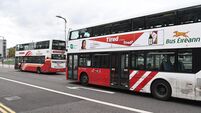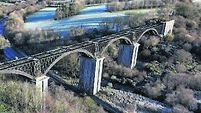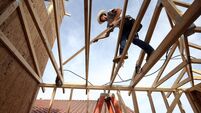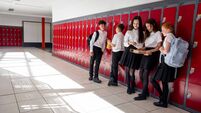Michael Moynihan: Cutting down trees to help the environment leaves me stumped

Bishop Lucey Park will be losing some mature trees to be replaced by some semi-matures ones.
I've threatened readers in the past with my story about Joyce Kilmer, the man who wrote the poem Trees, and if there’s one thing I know from reading Elmore Leonard it’s that if you issue a threat you have to follow through with it (preferably with snappy one-liners).
But before I do ... there are a few others whose work may be more relevant this morning. Richard Forbes and J C Flanagan, to be precise, would be as baffled as any of us with one very specific aspect of modern life on Leeside.
What is going on with trees in Cork?
The removal of trees is becoming something of an epidemic.
Take Bishop Lucey Park as a case in point. There are significant plans in motion for the redevelopment of the park, plans which have attracted attention because they appear to involve the removal of some green space and trees.
Specifically, there are plans for seven mature trees to be removed and others to be pruned as part of an overhaul of the general neighbourhood.
As reported in this newspaper, senior executive city architect Cathal O’Boyle told architecture students at a symposium held at UCC’s Cork Centre for Architectural Education: “I’d like to dispel the notion that what we are doing is concreting over the park. That’s definitely not what we’re doing.”
In the interests of fairness, when the plan was first mooted it was suggested that semi-mature trees would be planted to replace the mature ones being removed, but when you take a step back and review the proposition it doesn’t get much better.
The city council is cutting down trees growing in a public park. That’s not a sentence that you’d expect to write every day.
This might be more palatable, moreover, if it were not for the fact that the Freemason’s premises on Tuckey Street, which backs onto the park, has been given planning permission for an extension which will take over 44 square metres of the park.
I acknowledge that 44 square metres is probably not an enormous amount of space. I also acknowledge that the accompanying “removal of 15 semi-mature birch trees, nine of which are in good condition” is not the same as dousing the entire area in petrol and flicking in a lit match, particularly as “it is proposed to plant 15 replacement birch trees immediately north of the extension”.
However, a private enterprise annexing public space is inherently unsettling, all the more so when that private enterprise is a byword for secrecy to begin with.
The fact that there’s so much disruption of the natural environment being aided, and sometimes enacted, by the municipal authority responsible for that environment?
That’s also disappointing, particularly when one looks at that authority’s track record in recent times.
Robot trees
For instance, last week these pages carried a report from Eoin English on our famous robot trees, the large brown . . . landmarks to be seen at various places in Cork. These machines, or CityTrees to use the approved terminology, are intended to help with air quality, but the report on their success or failure in doing so has been slow to arrive.
“‘The report will be published before the end of March. That is the target,’ said David Joyce, the head of the council’s operations directorate. But he could not provide an exact date for publication,” Eoin reported.
“He (Joyce) did confirm, however, that the City Tree devices, which cost some €404,000, are not designed to tackle nitrogen dioxide (NO2) which was the focus of the massive Clear Air Together city science study, the results of which were launched on Wednesday night.
“He said the devices are designed to tackle particulate matter only, trapping larger particles of air pollution in their moss walls.”
However, as pointed out by Jon Sodeau, Professor Emeritus of Chemistry at UCC, Cork City Council itself has an interesting take on what the tree cyborgs — TreeBorgs, if you will — actually do.
If you trip over to the city council's website there’s a very interesting passage on trees.
“How do the CityTrees work? The moss absorbs air pollutants such as particulate matter (PM) and nitrogen oxides (NOx) and emits clean air.”
There seems to be a contradiction here between the website stating the CityTrees absorbs both particulate matter and nitrogen oxides, while council representatives say the CityTrees are designed to tackle particulate matter only.
Who will clear this up?
If only these, ah, much-loved CityTrees had a voice of their own, perhaps an inbuilt audio programme which allowed them to explain their mission clearly to everyone.
The next model will have that feature, maybe. Though that would mean replacing these mature CityTrees with semi-mature ones. Still, we'll know how to do that after the experience of Bishop Lucey Park, no?
That’s not the end of the city’s tree-related travails — or treevails, if you will (Less of the new words, if you will — ed).
If you roll out the Boreenmanna Road you can pass dozens of trees which have yellow ribbons tied around them. This is a reaction to the BusConnects plan, a draft of which has specific implications, in this part of the city: 73 properties along the route could be affected, 283 on-street parking spaces may be lost, all the traffic coming out of Douglas may be filtered down Wallace’s Avenue past a primary school ... the yellow ribbons identify a part of the plan which has annoyed locals on an entirely different basis.
The ribbons are meant to indicate the 191 trees which could be felled if the BusConnects plan goes through as envisaged, though BusCondemns seems a more accurate description at this point.
The need to improve public transport is universally acknowledged by all participants, willing or not, in Cork’s traffic swamp, not to mention the wider implications of cutting carbon emissions to counteract climate change.
Who thought that cutting down dozens of trees would be an integral part of that plan? To widen what is already one of the widest roads in Cork, at that?
Creating “a more sustainable and liveable city” is one of BusConnects’ stated aims. Nothing says sustainable and liveable like cutting down mature trees, I suppose.
A good thing the BusConnects planners aren’t relying on outdated Ordnance Survey maps to organise those Cork routes, as such maps wouldn’t do justice to features like the number of trees on ... anyway. Close escape, is all I’m saying.
Is this an unfortunate coincidence, random events occurring at roughly the same time? The alternative, a growing lack of respect for the natural world within the urban environment, would be worrying to contemplate. Cork’s parks and green spaces have long been one of the city’s most attractive features.
So attractive, in fact, that in one of the best-known songs about Cork Richard Forbes and J C Flanagan immortalised the elm trees of the Mardyke. Good thing, too. What would they have immortalised if writing the song nowadays? Particulate matter?
CONNECT WITH US TODAY
Be the first to know the latest news and updates














